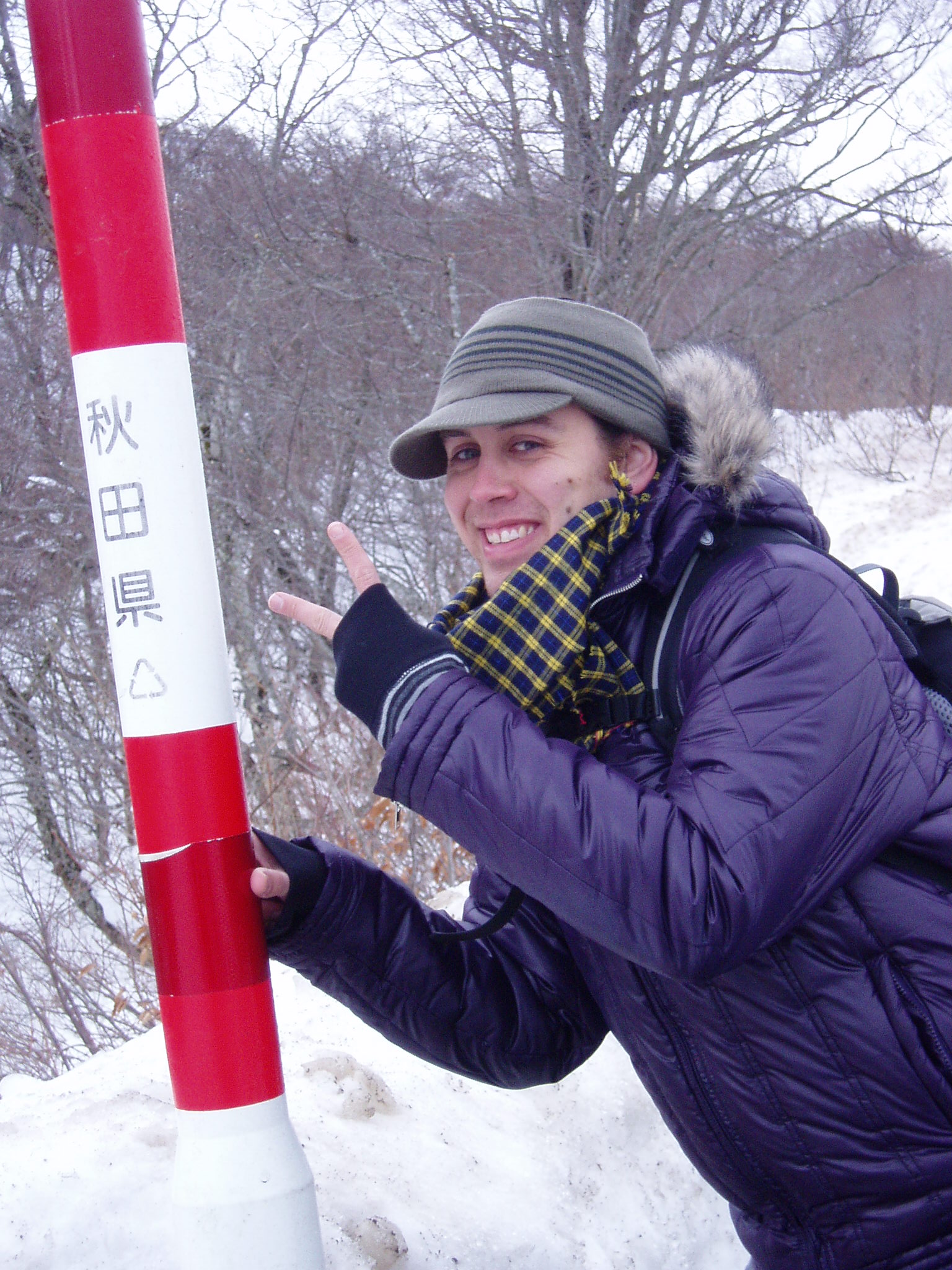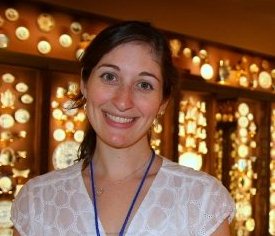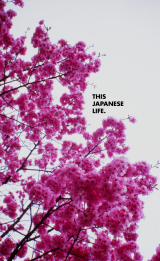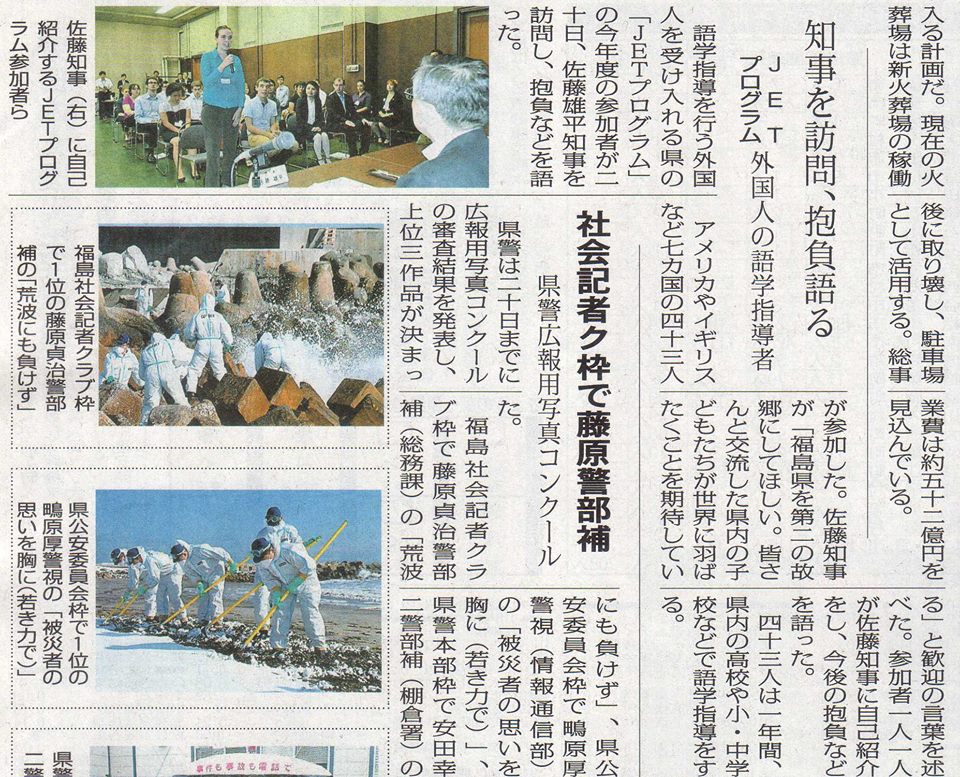Kyodo News “JET Alumni” Series: Dominic Abordo (Akita)
News agency Kyodo News has recently been publishing monthly articles written by JET alumni who were appointed in rural areas of Japan, as part of promotion for the JET Programme. Below is the English version of the column from February 2014. Posted by Celine Castex (Chiba-ken, 2006-11), currently programme coordinator at CLAIR Tokyo.
********
Originally from San Francisco, CA, Dominic Abordo (Akita-ken, Kosaka-machi, 2008-11) holds a Bachelors Degree in English Literature with a minor in East Asian Languages from Berkeley University. He spent three years working as a Coordinator for International Relations (CIR) in rural Akita before enrolling in a Master’s degree in Social Work from Columbia University, NY. He currently works as a Freelance Consultant in Social Work in New York.
A “Big City Boy” in Snow Country

“The one thing that I will continue to share with my friends and family is that the people of the small town of Kosaka-machi have some of the biggest hearts in the world.”
Akita (əˈkiːtə), noun: 1. one of the northernmost prefectures on the Japanese island of Honshu; 2. the prefecture that I, Dominic Abordo, called “home” for three years.
If you ask the average American about Japan, it is highly unlikely that Akita Prefecture – a gem of the Tohoku Region famous for heavy snowfall, rice, kiritanpo, and sinister mountain demons called namahage – will be included in his or her response. Despite living in Japan for three years prior to the JET Programme, I, too, knew very little about my future home. Thus, I was admittedly nervous when I first arrived in Kosaka-machi, a small town of approximately 6,500 people located in the northeastern corner of Akita. I assumed that my time as a Coordinator for International Relations (CIR) would be full of new adventures, challenges, and opportunities, but I had no idea that the experience would have such a positive and lasting impact on my future.
Although it took almost one year to master the local dialect, Kosaka-machi soon became a second home to me. The natives were eager to introduce me to the natural beauty and hidden treasures of their hometown, including landmarks such as Nanataki Waterfall, Lake Towada, and the Korakukan kabuki theater. They often accompanied me to the best restaurants, bars, and izakaya in the area, sharing personal stories about their families, jobs, and travel experiences over a meal or a few drinks. Elementary school students and adults alike offered warm greetings when we ran into each other around town. Perhaps most importantly, they did everything they could to make sure that I was happy, healthy, and an active part of the community. Little did I know that my love for dance, music, and performing arts would enable me to form lasting connections with so many of them. Read More
Japan Times features JET alum Matthew Cook and his work with Osaka’s English Reformation Project Team
****************************
Very nice article on JET alum and former AJET Chair Matthew Cook (Osaka-fu, 2007-12) about his path from JET to becoming an agent of change for the Japanese English education system through is unique role with Osaka Prefecture’s Board of Education. Matt is also the founder of the Kansai JET Alumni group. FYI, you can also click here for a recent JQ profile of Matthew Cook by JETAA New South Wales‘ Eden Law (Fukushima-ken, 2010-11) .
Changing the system starts by challenging it
BY TERU CLAVEL
Just seven years after first participating in the JET program in Osaka, Matthew Cook from Danville, Virginia, is making great strides as a pioneer of English-language education reform in Japan. Having never previously been to an Asian country, Cook is now one of seven members of Osaka’s groundbreaking English Reformation Project Team, having been appointed by Osaka superintendent Toru Nakahara in 2013. With an unswerving commitment to English-language education and a little luck, Cook’s efforts may pave the path for Japan’s next generation of global leaders.
Cook applied to the JET (Japan Exchange and Teaching) program because it was “the most lucrative, stable and safe way to get to Japan.” Having run his own karate dojo in the United States, he felt the need to gain a deeper understanding of the Japanese culture behind it. However, Cook was waitlisted and needed to make a snap decision when he was offered a position within a month of the JET start date. “I had totally assumed that I wasn’t going to get in,” he says.
Cook’s initial placement was less than ideal, though. He was forewarned that the Osaka junior high school to which he was assigned might be challenging, but he was not prepared for the “few students who were stopping class altogether, violence in the classroom or kids getting up and leaving.” Read More
Japan Times article on AJET report on disaster preparedness
Great article written by a JET alum journalist Patrick St Michel.
Clarify Your Role, Prepare Before a Disaster Strikes
When she first arrived in Japan from Ireland in 2008, Sarah Hickey was mostly concerned with adjusting to her new life in Fukushima Prefecture. The Japan Exchange and Teaching (JET) Programme placed her in Iwaki, which is itself a large city, but she found herself near the coast in less metropolitan surroundings.
“There was nothing there, just a supermarket and a school I was teaching at. It was an incredibly beautiful place — but it was tough,” she says.
Gradually, Hickey grew accustomed to her corner of Iwaki, where she taught English at several junior and senior high schools. One thing she wasn’t ready for were natural disasters, which she says scared her. She also doesn’t recall receiving information about what to during a natural disaster at school during JET’s Tokyo orientation or when she first arrived in Fukushima. Read More
JET alum Harry Hill named Chairman of U.S. CULCON
 Here’s a link to the official post on the CULCON website: http://culcon.jusfc.gov/news/harry-hill-becomes-chairman-of-u-s-culcon
Here’s a link to the official post on the CULCON website: http://culcon.jusfc.gov/news/harry-hill-becomes-chairman-of-u-s-culcon
FEBRUARY 18, 2014
The Japan-U.S. Friendship Commission and the U.S. CULCON Panel are pleased to announce the appointment of a new Chairman, Mr. Harry A. Hill.
Mr. Hill, a native of New York City, has served as President and CEO of Oak Lawn Marketing, a branding and media company that owns Shop Japan, the largest infomercial brand in Japan, since 2006. He brings with him a wealth of experience related to educational and cultural exchange and entrepreneurship, having lived and worked in Japan for nearly thirty years. Mr. Hill served as a participant on the Japan Exchange and Teaching Programme and its precursor program, the Monbusho English Fellows from 1987-1990 in Gifu Prefecture, where he created a strong network of individuals and government officials who would later help him in building his professional career. His extensive professional experience includes founding H&R Consultants, a leading lease providing and relocation service in Tokyo and Nagoya. In addition, Mr. Hill has been actively involved in numerous charitable and non-profit organizations, including the U.S.-Japan Bridging Foundation, where he has been a member of the Tokyo Advisory Committee and long-time sponsor of its scholarship program. “Mr. Hill will be an asset to the Japan-U.S. Friendship Commission and CULCON, bringing strong leadership experience as a successful entrepreneur, and a deep passion for strengthening the U.S.-Japan relationship through educational and cultural exchange,” says Executive Director Paige Cottingham-Streater. Mr. Hill’s expertise on Japan and cross-cultural communication skills will further advance the Commission and CULCON’s efforts to invest in Japanese and American studies, people-to-people exchanges and artistic and cultural initiatives.
Mr. Hill succeeds Read More
Kyodo News “JET Alumni” Series: Laura Tasharofi (Kochi)
News agency Kyodo News has recently been publishing monthly articles written by JET alumni who were appointed in rural areas of Japan, as part of promotion for the JET Programme. Below is the English version of the column from January 2014. Posted by Celine Castex (Chiba-ken, 2006-11), currently programme coordinator at CLAIR Tokyo.
*********
Laura Tasharofi (Kochi-ken, Yusuhara-cho, 2004-07) hails from Gold Coast, Queensland, Australia. After a Bachelors Degree in Japanese Studies from Griffith University, Gold Coast, she joined the JET Programme and was placed as a CIR in a little Shikoku town where she spent the next three years. She currently works as the Student Loan Coordinator for Queensland TAFE and has been the President of JETAA Queensland since 2011.

“I always encourage young people I meet to consider the JET Programme as a life experience, and I am eternally grateful for the opportunities the JET Programme gave me.”
The Town Above the Clouds
Yusuhara: Town Above The Clouds (梼原町:雲の上の町). With a slogan like that, I suppose it should have been obvious, but as my supervisor drove me home from Kochi Ryoma Airport, I couldn’t believe how far we were climbing into the mountains. The deep green pine trees were towering over the winding road, and there were wisps of low cloud around us after the rain on that hot, humid day. The scenery was beautiful. Little did I know, I would spend the next three years becoming part of a wonderful community and making life-long friends.
Yusuhara had a population of a little over 4,000 people at that time. It is famous for being on the route that Sakamoto Ryoma took when he made his crusade to bring about the Meiji Restoration. You can follow the signs and walk the ‘Sakamoto Ryoma escape route’ (坂本竜馬 脱藩の道), through the hills to finish in Ehime-ken. It has a beautiful onsen and hotel, a pretty river and it is a short drive to the Tengu Highlands. Such a picturesque place, but there weren’t many tourists in those days. Some time after I left, NHK ran a TV series about the life of Sakamoto Ryoma, and that put Yusuhara on the map as a tourist destination for fans of the show.
In a small town like that, a tall Australian woman like me really stood out. People quickly came to recognise me. Everyone would say ‘good morning’, or ‘hello’ as I travelled to work or walked around town on the weekends. They knew where I lived and which car I drove. I very quickly learned that everyone knew where I was and what I was doing at any given time. At first I felt like I had lost my privacy, but I soon felt very safe and comfortable living in a small, friendly community where everyone knows each other.
I was quite busy as a CIR. I spent a lot of time visiting schools to do cultural and English lessons with kids from kindergarten up to Junior High School. I taught the kids how to play cricket, how to make rocky road (chocolate filled with marshmallows, nuts and cherries), I arranged a letter and Christmas card exchange between some of the students in Yusuhara and students at the school where my mum works in Tasmania. I assisted with the annual overseas study trip for 10 students from our town to our sister school in Queensland. I helped out at town events like the marathon and the kagura taikai (神楽大会). Read More
Japan Times: “Japanese firms mostly unaware of benefits of hiring from JET ranks: poll”
Article from the Japan Times about a Keizai Doyukai survey that indicates that Japanese companies are behind the curve compared to foreign companies with regard to hiring JET alumni, even though they possess qualities such as familiarity with Japanese language and culture than many Japanese companies need.
Note to Japanese companies: If you want to reach JET alumni, it’s as easy as e-mailing your job listings to jetwit [at] jetwit.com. It’s the best way to disseminate your job listings since JETwit jobs posts get echoed by JETAA chapters, and it’s free!
Japanese firms mostly unaware of benefits of hiring from JET ranks: poll
BY MASAAKI KAMEDA
STAFF WRITER
Japanese companies are less aware than their foreign counterparts of the government-sponsored Japan Exchange and Teaching Program and are thus missing out on an opportunity to hire foreigners who have the skills they need, a recent survey by a major business lobby showed.
The Japan Association of Corporate Executives (Keizai Doyukai), which conducted the survey released Friday, noted that domestic companies need to strategically hire former JET teachers and urged the government to create a mechanism to facilitate match-making opportunities for them.
The Keizai Doyukai survey, carried out between late November and December, said that only 18 percent of the 167 responding domestic companies knew about the JET program, and that only nine had hired former JET personnel.
By comparison, 83 percent of the 23 foreign companies and embassies who responded said they knew about the program and had employed past JETs. Read More
Kyodo News “JET Alumni” series: Jenson Deokiesingh (Toyama)
News agency Kyodo News has recently been publishing monthly articles written by JET alumni who were appointed in rural areas of Japan, as part of promotion for the JET Programme. Below is the English version of the column from December 2013. Posted by Celine Castex (Chiba-ken, 2006-11), currently programme coordinator at CLAIR Tokyo.
*********

I am reminded that my love story was very much a mutual one and I fondly think, “In life we meet, only to part, so we can meet again.”
Untitled
I have always loved Yayoi Kusama. There’s an unexplainable magic and unorthodox beauty about her signature polka dot patterns. I had seen compelling images of her kaleidoscopic, “Love is Calling,” installation designed specifically for the Mori Art Museum’s 10th Anniversary Exhibition and immediately knew I had to see it.
On September 1st, my last day in Japan and ironically the last day of the “All You Need Is Love” exhibition, I went searching for Kusama to bid her a final farewell.
As I meandered from one provocative exhibit to another, I found myself riveted to the entrance of the section, “Losing Love”. Written on the stark white wall, in simple black text, were the words: Great love stories are often about the encounter with and subsequent loss of loved ones. I stood there, in a trance, repeating these words, over and over, until they became deeply etched in my memory.
A film of tear glazed my dark brown eyes; wedged in my throat was a painful lump; and my heart slowly crumbled with each excruciating beat it gave. The inevitable truth I was desperately trying to avoid was now blinding me in a sobering reality. My life as a JET, my Japanese love story, was irrefutably over.
On Friday, October 18th, I had my first job interview since returning to my vibrant and colourful country of Trinidad and Tobago. Truthfully, the interview was going terribly. A frightening combination of nerves and adrenaline had left me uncharacteristically inarticulate. I was about to cite it as one for the history books, when the interviewer inquisitively said, “Please tell me about your experience on the JET Programme.”
That one sentence was all I needed to give me the confidence I had momentarily lost. With an inescapable smile imprinted on my face, I gleefully declared that living and working in Japan have been incontrovertibly the best experience of my life thus far. And, it truly was.
My first years in Toyama are as vivid and clear as Toyama’s spring mountain waters. The hot embarrassment pulsating through my body as I wished the staff after a long day’s work “Gochisousama deshita (Thank you for the feast)” instead of the customary “Otsukaresama deshita (Thank you for your hard work)” still turns my brown cheeks rouge. Excitedly waking up early in the morning for my first school photo, wearing my best suit, whistling as I biked to work, and then having a crow defecate on my new suit still brings me uncontrollable laughter. Taking a lunch break at the school’s garden, reading Haruki Murakami’s “Sputnik Sweetheart” and then being stung by a several caterpillars still gives me chills. However, crazily running into the staff room, shouting, “Itai! Abunai! Itai! (Pain! Dangerous! Pain!)”, and having my vice principal heroically take the school’s vacuum to vacuum my back change those shudders into immeasurable smiles. Read More
Kyodo News “Rural JET alumni” series: Elizabeth Gordon (Iwate)
News agency Kyodo News has recently been publishing monthly articles written by JET alumni who were appointed in rural areas of Japan, as part of promotion for the JET Programme. Below is the English version of the column from November 2013. Posted by Celine Castex (Chiba-ken, 2006-11), currently programme coordinator at CLAIR Tokyo.
*********

“I discovered through these exchanges that the people with whom I was talking wanted to know as much about me, about Chicago and about America as I wanted to know about them, Iwate and Japan. Through these interactions over the course of two years I began to gain a small understanding of the subtle nuances that were part of the culture in which I was living.”
Originally from Chicago, Elizabeth Gordon (Iwate-ken, Ninohe-shi, 2003-05) holds a Bachelors Degree in Psychology with a minor in Japanese Studies from Northwestern University, IL, and a Master’s degree in East Asian Studies from Columbia University, NY. She spent two years teaching English in rural Iwate before joining the Japan Foundation in New York as a Program Officer. She currently works as the Director of Private Events of the Adler Planetarium in Chicago.
Soba Diplomacy
Noodle making is an art, not to be taken lightly. Only a true master can produce the perfect noodle. After the wooden board is cleaned, the ingredients are kneaded in perfect rhythm until the correct consistency is achieved, and only the master knows for sure when that is. The rolling pin goes back and forth in a circular motion but forms a perfect rectangle, which is folded in half, then in half again, and in half again. Ever so delicately, the master cuts, slice after slice, all exactly the same width. They are cooked for just the right amount of time and then served with a simple dipping sauce sprinkled with scallions. The movements were ingrained in his muscles. I imagine he could have completed the whole process with his eyes closed. There is simplicity in the process, but the flavor is layered and complex.
When I arrived in Ninohe City, Iwate Prefecture in the summer of 2003 as a participant on the JET Program, I did not know a soul, nor had I ever heard of Iwate Prefecture. There was a short orientation in Tokyo, followed by a shorter orientation in Iwate’s capital city of Morioka. It was on the final day of orientation in Morioka that I met my supervisor, Mr. Sato. He picked me up and we drove the one and a half hours through the countryside back to Ninohe City. Mr. Sato did not speak much English and his heavy Iwate dialect was difficult for me to understand. We did, however, find common ground in a little bit of sports but mostly through food. I listed all of my favorite Japanese dishes, and he loved the fact that I could eat with chopsticks. He brought me to the Board of Education office and showed me my desk, which would be my home base for the next two years.
There was no rest for the weary, however. Before I could sit down I was whisked away on a driving tour of the entire city. We stopped at my two junior high schools and one of the eight elementary schools at which I would be teaching. I was asked to give a short self-introduction at each location. We also stopped at city hall to meet the mayor, and at the bank to open an account. Back at the board of education it was suggested that I be taken to the grocery store before I was dropped off at home for the evening. Read More
Kyodo News “Rural JET alumni” series: Nic Klar (Niigata)
News agency Kyodo News has recently been publishing monthly articles written by JET alumni who were appointed in rural areas of Japan, as part of promotion for the JET Programme. Below is the English version of the column from October 2013. Posted by Celine Castex (Chiba-ken, 2006-11), currently programme coordinator at CLAIR Tokyo.
********
Originally from Australia, Nicholas Klar (Niigata-ken, Itoigawa-shi, 1995-97) wrote the book “My Mother is a Tractor” about his life as an ALT in Omi, Itoigawa, Niigata-ken. After JET he worked for many years as a college counsellor and History teacher in international schools before returning to Japan to live. He now runs a small business in the Japan Alps, “Explore the Heart of Japan” as well as a popular travel website (http://myoko-nagano.com).
Remember that here all is enchantment, – that you have fallen under the spell of the dead, – that the lights and the colours and the voices must fade away at last into emptiness and silence. –Lafcadio Hearn
It was a stark winter’s day as usual in Niigata-ken, grey like sodden blanket. Not one that I had set out on seeking ghosts, but it suited the mood. As I changed trains in Naoetsu for Ōmi the old tempura stand I had been hoping for a snack at was still there, but today it was closed. It seems even the sturdy yukiguni could not stand the sort of weather that was being hurled at them this winter from across the Japan Sea. I settled into my seat, its soft orange covers familiar like an old friend, and waited for the delayed departure. I scrubbed the mist from the brown streaked windows with my hand as the motor idled and the minutes slipped by. Outside schoolboys in their traditional Prussian kit seem oblivious to the biting gusts of artic-like snow. Eventually with the sound of the station attendants whistle the doors snapped shut and the blue and white carriage groaned away from the platform.
As we crossed over the dark frigid waters of the Himegawa almost an hour later I grew excited. I hadn’t been back to the haunts of my old town for years. It was an unplanned visit and no-one really knew I was coming. I looked over for the local chugakko as the train passed by, obscured now by the construction of the new Hokuriku shinkansen. Framed behind those were the mountains I had loved so much. So many times I had taken my bike up into those North Alps making new discoveries, getting lost in the awesome beauty of its nature. Days of sunshine, days of rain. How I missed them. And the ghosts that inhabited them.
To the right there was a slight glimpse of my former apartment block. Not mine anymore, not for many years. In fact I think it now lays empty, apart from maybe a ghost or two, as the town depopulates. Tall, grey, forbidding – once referred to by a friend as, “…classic 1950’s communist Romanian style architecture”. The memory of that remark brought a brief smile to my face. Yet, it is the only place I will ever live in that has a sea view at the front and the mountains at the back. Grand views of God’s great vista on tap.
When the doors clunked open at Ōmi eki it was if nothing had changed. The chimes rang the same they had all those years ago and the black asphalt platform lay several centimetres thick with windswept snow. It felt soft under my feet as I began my ascent up the cold cement stairs. Standing in his post was my first metaphorical ghost – Watanabe-san the station master in the same blue-clad uniform, looking not a whit older than when we had last met a few years ago. He didn’t recognise me of course, even though I had taught his daughter at Ōmi chugakko. During my stay many of the station attendants had greeted me by name each time I passed through the gate. The inside of the station was a time capsule still painted the same green, apart from a more modern poster here and there, populated by even more ghosts of my memories. Local oba-chan in the waiting room still sat chatting on wooden bench seats around the kerosene heater behind glass doors. The three old shuttered-up ticket windows still existed – a sad reminder from the more grandiose boom days of Ōmi. Perhaps they were stubbornly retained in the forlorn hope that those times may yet return once again. Read More
Japan Times article on ALTs and discipline in the classroom
Thanks to AJET Chair Kay Makishi for bringing this to JETwit’s attention. Notably, in addition to the current JET who is quoted, Aaron Miller (Ehime-ken, 2002-04) is also quoted in connection with his recently published book on discipline in the Japanese education system and the writer of the article is a current JET. On a related note, a really good book on discipline in the classroom is Discipline with Dignity, though not sure how it works cross-culture:
When it comes to discipline in class, leave it to the locals
BY PATRICK ST. MICHEL
SPECIAL TO THE JAPAN TIMES
Aaron Joseph remembers the email Interac sent him regarding his school placement in Sakai, Osaka, in August 2012.
“There was a line that said, ‘It’s kind of a rough school, but we are sure you can handle it.’ ”
It didn’t take long for the Nashville-born Assistant Language Teacher (ALT) to see the company wasn’t kidding about Otori Junior High School.
“My first day teaching — my very first class — one kid asked me, ‘Are you a miserable f-ck?’ I did a double take — it was perfect pronunciation.” He says the next six months at Otori were filled with disinterested classes, instances of students smoking inside and fights — some nearly breaking out between students and teachers.
Although his situation was extreme, Joseph faced a challenge shared by many ALTs in Japan: how to deal with misbehaving students. Not every ALT has to stare down scrappers and smokers everyday, but most have dealt with loud, inattentive or disruptive classes and students, sometimes frequently. How does a non-Japanese teacher approach discipline in these scenarios?
For Joseph, it was clear: don’t engage. “Interac made it pretty clear at orientation that discipline was not our business,” he says. “Don’t get in a battle of wills with a teenager — if you get mad at them, you can’t do anything.”
Private dispatch companies tend to be direct about discipline; in their teaching manuals, businesses such as Interac or Aichi Prefecture-based Altia Central strongly advise ALTs to leave matters of discipline to fully licensed teachers.
For teachers working through the Japan Exchange and Teaching (JET) Programme, or those tasked with leading classes by themselves, disciplinary procedures aren’t so straightforward. The JET handbook for ALTs never explicitly states that a foreign teacher should avoid discipline, offering up only strategies to stop students from becoming disruptive. [The Japan Times contacted the education ministry about official procedures, but did not get a response in time for publication.]
Daniel Nicholls, a JET ALT based in Mie Prefecture, says he has never been told by JET, his board of education or his school not to discipline students. Read More
Kyodo News “Rural JET alumni” series: Daneeta Loretta Jackson (Fukuoka)

“My JET programme experience and my seven years in Japan have had a profound influence on me. It changed me into a more peaceful, communal person.”
News agency Kyodo News has recently been publishing monthly articles written by JET alumni who were appointed in rural areas of Japan, as part of promotion for the JET Programme. Below is the English version of the column from September 2013. Posted by Celine Castex (Chiba-ken, 2006-11), currently programme coordinator at CLAIR Tokyo.
********
Daneeta Loretta Jackson (Fukuoka-ken, Buzen-shi, 1993-95) was born and raised in the backwaters of Southeast Louisiana. She was educated at public school where she discovered her love for storytelling. She holds a B.A. in English from Loyola University of the South, an M.A. in English from George Mason University, and an M.A. in the Art and Technique of Filmmaking from the London Film School. Her hobbies are international travel, watching movies, anything having to do with dogs, and sleeping. She works as a writer and filmmaker and is a Creative Producer at the ElekTrik Zoo, an arts partnership she co-founded with her husband, Patrick Jackson. She joined the JET programme in 1993 because she wanted adventure. It had a profound affect on her and changed the course of her life.
I was a JET Programme participant from 1993 to 1995 in Buzen-shi, Fukuoka-ken. I never expected to go to Japan. I never dreamed about it when I was a child like so many of my counterparts did. I don’t mean to sound flippant, but the JET Programme for me was a kind of accident. It is too long of a story to recount here. In short, my husband applied for the both of us. He requested a rural post in Fukuoka-ken because a boy from his Japanese baseball team in California was from Fukuoka. When he got word we had been accepted, he told me we were going to Japan. I had about two months to prepare.
Before I knew it, I was on a plane to Tokyo in July of 1993. The first few days were a whirlwind. The orientation in Tokyo and the jet lag made it seem like I was in some sort of dream. I had no idea what awaited me in the countryside, I couldn’t speak much Japanese, and everything seems so strange… so different from my native Louisiana. Read More
Book: “This Japanese Life” published by JET alum blogger Eryk Salvaggio
 Thanks to AJET Chair Kay Makishi for the heads up on Fukuoka JET alum Eryk Salvaggio who writes the blog “This Japanese Life” and recently published a book by the same name. You can read more about Eryk in this Japan Times interview with him from 2012.
Thanks to AJET Chair Kay Makishi for the heads up on Fukuoka JET alum Eryk Salvaggio who writes the blog “This Japanese Life” and recently published a book by the same name. You can read more about Eryk in this Japan Times interview with him from 2012.
About the book: http://thisjapaneselife.org/this-japanese-life-the-book/
Most books about Japan can tell you how to use chopsticks or say “konnichiwa.” Few tackle the real stress of life in a radically different culture.
The author, a three-year resident and the writer and researcher behind one of the best Japan blogs, tackles the thousand tiny uncertainties of life abroad with honesty and wit.
Perfect for anyone about to leave home for Japan or elsewhere, This Japanese Life will deepen any reader’s understanding of Japanese culture as it’s fused into a method of dealing with the hardships of working and living there.
About Eryk:
Eryk Salvaggio was an American newspaper editor in Bangor, Maine before teaching English in Japan with the JET Program. He lived in Fukuoka City from 2010-2013, writing a blog, This Japanese Life, about Japanese culture and the tiny anxieties of being an expatriate.
The site was named one of the best Japan Blogs by Tofugu and was spotlighted by The Japan Times. Salvaggio has written for McSweeney’s, The Japan Times, Tofugu and Kulturaustausch.
His work as a visual artist has been covered in The New York Times and elsewhere.
He currently lives in London.
JETwit mentioned in Japan Times article “JET Alumni: Advocates for Japan”
A great Return On JET-vestment article that ran today in the Japan Times:
JET alumni: Advocates for Japan
Program lauded for continuing to bear cultural fruit, friendships
BY AYAKO MIE
STAFF WRITER
Here’s the full article: http://www.japantimes.co.jp/news/2013/09/03/national/jet-alumni-advocates-for-japan/#.UiaU_GRATv0
Here’s the quote:
Steven Horowitz, who was a JET in Aichi Prefecture from 1992 to 1994, likened his former colleagues to a global expat community of around 60,000 people in terms of their shared affection for Japan. “I think it is going to pay . . . dividends for years and years to come,” he said.
To consolidate the alumni network, Horowitz runs JETwit.com, a website that accumulates information about alumni and Japan-related jobs.
Let’s Talk Japan Podcast, Episode 15 – JET Alumni Bike Shikoku’s 88 Temple Pilgrimage
Let’s Talk Japan is a monthly, interview format podcast covering a wide range of Japan-related topics. Host Nick Harling (Mie-ken, 2001-03) lived in Japan from 2001 until 2005, including two great years as a JET Program participant in Mie-Ken. He practices law in Washington, D.C., and lives with his wife who patiently listens to him talk about Japan . . . a lot.
In this episode, Nick speaks with JET Program alumni Chelsea Reidy and Elayna Snyder about their upcoming 900-mile bicycle tour of Shikoku’s famous 88 temple pilgrimage.
Listen to hear them describe their creative “Temple by Temple Project,” which they are funding through Kickstarter, and how they plan to share their adventure with others.
To learn more, check out their website, www.bigricefield.com, and the Temple by Temple Project on Kickstarter.
Enjoy!
Nick
New Fukushima JETs make the local newspaper
Just saw this posted to the JETAA New South Wales Facebook group which was re-posted from the Fukushima ALTs Facebook group.
“New JET members are in today’s newspaper (Fukushima Minpo). It says 43 new JET members visited the governor and expressed their hopes.”




